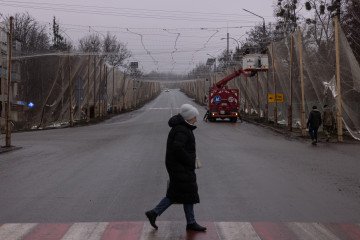- Category
- War in Ukraine
Ahead of Winter, Russia Intensifies Strikes on Ukraine's Energy System and Power Outages Return
Due to new damage to energy facilities, power outages for civilians have returned, with electricity being cut off for 4–6 hours daily.
In November 2024, Russia resumed mass strikes on Ukraine's energy infrastructure. On the morning of November 17, 120 missiles of various types and 90 Shahed-136 drones were launched, primarily targeting Ukraine’s energy system across the country.
As a result, Ukrainians are once again experiencing the effects of these attacks: planned power outage schedules have been reintroduced. These outages are necessary to stabilize the grid, repair damaged facilities, and carry out maintenance. Ukraine has not disclosed specific damage from the November 17 attacks for security reasons, but it is known that power generation facilities in several regions were hit, along with other localized damage.
Ukraine's energy system remains a key target of Russian attacks despite these facilities being critical civilian infrastructure protected under the Geneva Conventions. Russia continues to strike them relentlessly.
Since the start of the full-scale invasion, about 90% of Ukraine's thermal power plants (TPPs) and up to 40% of hydroelectric power generation have been destroyed. Solar power stations and gas-fired generation facilities are also frequently targeted. In the summer of 2024, Russia extended its attacks to include energy transmission systems, such as substations of various capacities.
Due to constant bombardments in the summer of 2024, Ukrainian consumers experienced power outages lasting up to 12 hours daily.
Localized but smaller-scale strikes continued over recent months, with Russia targeting facilities in Sumy, Poltava, Zaporizhzhia, and Dnipropetrovsk regions. Energy infrastructure in the Odesa region is also under constant attack. Following the strikes on November 17, up to 700,000 households were left without electricity, with full restoration taking several days.
The Hardest Winter Yet
Ukrainians are being warned that the coming winter could be one of the toughest in nearly three years of full-scale war. Several factors contribute to this outlook:
Extensive Damage: Russian forces have destroyed numerous power generation facilities. Rebuilding them is challenging, time-consuming, and costly, with necessary equipment often unavailable. Ukraine’s partners have even dismantled old power plants in their own countries to provide equipment for Ukraine to speed up restoration efforts. Some facilities, such as the Kakhovka Hydroelectric Power Station destroyed by Russia in June 2023, cannot be rebuilt until after the war. Additionally, TPPs near the border have been destroyed and are irreparable.
Ongoing Strikes: Russian missiles and drones consistently target Ukrainian energy facilities across the country. Currently, Ukraine lacks sufficient air defense systems to fully protect its energy infrastructure, as well as enough ammunition for these systems. In spring 2024, one of Ukraine’s largest TPPs could not be protected due to a lack of missiles for air defense systems. F-16 fighter jets, which began arriving in summer 2024, assist in intercepting targets, but Russia’s attacks remain relentless, with energy facilities being a primary target.
Occupation of a Nuclear Power Plant: The Zaporizhzhia Nuclear Power Plant, the largest in Europe, has been under occupation since 2022 and no longer supplies power to Ukraine. Russia uses the plant for nuclear blackmail, creating crisis situations, and has stationed troops there. Additionally, Russian forces occupy territories housing several large TPPs.
Insufficient Generation Capacity: Ukraine lacks sufficient energy generation to meet its own needs. Before the full-scale invasion, the country could fully supply itself and even export electricity to Europe. Now, generation is limited by strikes, occupation, and destruction. Imports from Europe are also constrained. As a result, during peak temperature fluctuations—such as winter cold spells—Ukraine’s own capacity will likely be insufficient to meet demand.
These challenges suggest a harsh winter ahead. Depending on the severity of the situation, Ukrainians may face power outages lasting from 4 to 12 hours daily or even longer. The scale of outages will depend on the intensity of Russian attacks and the availability of air defense systems.
In the meantime, Ukrainians are preparing for winter on their own: purchasing autonomous power systems, insulating homes, and using portable gas stoves. Businesses have adapted to the “generator economy,” relying on generators to continue operations during outages. Critical and social infrastructure also depends on small autonomous systems to maintain functionality during prolonged blackouts.
-29a1a43aba23f9bb779a1ac8b98d2121.jpeg)
-886b3bf9b784dd9e80ce2881d3289ad8.png)


-f88628fa403b11af0b72ec7b062ce954.jpeg)
-b63fc610dd4af1b737643522d6baf184.jpg)

